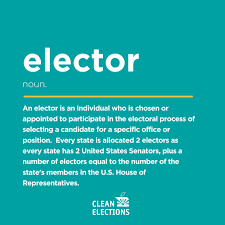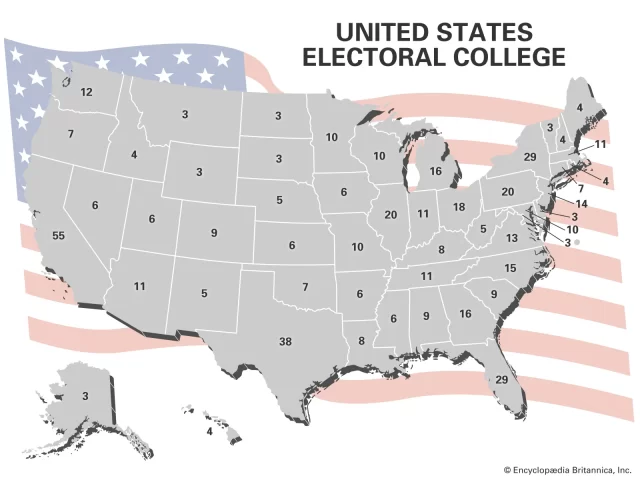Understanding the US Electoral College System
What is the Electoral College?
The Electoral College is a unique system used in the United States to elect the President and Vice President. It’s different from the popular vote system used in many other countries. Instead of citizens directly voting for the President, they vote for electors who then cast their votes for the President. This system was created by the Founding Fathers as a compromise between election of the President by a vote in Congress and election by popular vote.
Each state has a certain number of electors based on its total number of Congressional representatives: two Senators and a number of Representatives in the House. For example, California has 55 electoral votes because it has two Senators and 53 Representatives. The total number of electoral votes is 538, and a majority of 270 electoral votes is required to win the presidency.
How Does the Electoral College Work?
The process of electing a President using the Electoral College involves several steps. First, citizens vote in the general election, which is held on the first Tuesday after the first Monday in November. When people vote, they are actually voting for a slate of electors chosen by their political parties. These electors are pledged to vote for the party’s candidate.
After the general election, each state’s electors meet in their respective state capitals in December. They cast their votes for President and Vice President. These votes are then sent to Congress, where they are counted in a joint session in January. If a candidate receives a majority of the electoral votes, they are elected President. If no candidate gets a majority, the election is decided by the House of Representatives, with each state delegation casting one vote for one of the top three candidates.
Why Was the Electoral College Created?
The Electoral College was created to balance the influence of states with large and small populations and to address concerns about direct democracy. The Founding Fathers were worried that a direct popular vote might not be practical or fair. They wanted to ensure that smaller states would still have a voice in the election process, and they also wanted to create a buffer against potential mob rule.
The system was also designed to protect the interests of states with fewer people. By giving each state a minimum number of electors, regardless of its population, smaller states have a relatively greater influence than they would in a purely popular vote system. This compromise was meant to ensure that the President would have support across the entire country, not just in the most populous areas.
What Are the Pros and Cons of the Electoral College?
The Electoral College system has both supporters and critics. Supporters argue that it ensures that all states have a role in the election and that it prevents more populous states from dominating the process. It also helps maintain a federal system of government by balancing the influence of states.
Critics argue that the system can lead to outcomes where the candidate who wins the popular vote does not become President. This has happened in a few elections, such as the 2000 and 2016 elections. Critics also argue that it can lead to a focus on swing states—states that could reasonably be won by either major party—while ignoring those that are solidly Republican or Democratic. This can lead to uneven campaigning and policy focus.
How Are Electors Chosen?

Electors are chosen by political parties in each state. Each party selects its own slate of electors, who are usually loyal party members or individuals with a strong connection to the party. The number of electors each party can choose is equal to the number of the state’s electoral votes.
In most states, the electors are chosen through a party convention or by a vote of the party’s central committee. The electors are typically chosen months before the general election and are pledged to vote for their party’s candidate if that candidate wins the popular vote in their state.
What Happens If an Elector Doesn’t Vote for the Pledged Candidate?
In most cases, electors vote for the candidate they are pledged to. However, there are rare instances where electors may vote for a different candidate. These electors are known as “faithless electors.” The impact of faithless electors is usually minimal, as they are often a small minority and their votes are rarely decisive. Some states have laws that penalize or replace faithless electors, but these laws vary in their effectiveness.
The Supreme Court has ruled that states have the power to enforce laws requiring electors to vote for their pledged candidate, which helps ensure that the electoral process remains fair and orderly.
What Is the Role of Swing States?
Swing states, also known as battleground states, play a crucial role in the Electoral College system. These are states where neither major party has a clear advantage, and the outcome of the election is uncertain. As a result, candidates often focus their campaigns on these states, spending significant time and resources there.
Swing states can vary from election to election, depending on changing political dynamics and voter preferences. Candidates tailor their messages and policies to appeal to voters in these states, which can make them the focal point of presidential campaigns. This focus on swing states can sometimes lead to a disproportionate amount of attention and resources being directed there, while other states receive less attention.
How Has the Electoral College System Evolved Over Time?
The Electoral College system has undergone several changes since its creation. One significant change occurred with the 12th Amendment, ratified in 1804, which established separate ballots for President and Vice President to prevent issues arising from tied votes or disagreements between the two offices.
Another important change was the passage of the Voting Rights Act of 1965, which aimed to eliminate racial discrimination in voting and ensure that all citizens could participate in the electoral process. This act helped to increase voter participation and ensure that the Electoral College reflects the diverse makeup of the American electorate.
Despite these changes, the fundamental structure of the Electoral College has remained largely the same. The system continues to be a topic of debate and discussion, with some advocating for reform or abolition while others argue for its preservation.
What Are the Alternatives to the Electoral College?
Several alternatives to the Electoral College have been proposed over the years. One popular alternative is the national popular vote system, where the candidate who receives the most votes nationwide would win the presidency. This system is used in many democracies around the world and is often seen as a more straightforward way to elect a President.
Another alternative is the proportional allocation of electoral votes, where each candidate receives a share of the electoral votes based on their share of the popular vote in each state. This system would aim to make the Electoral College more representative of the overall vote.
Despite these proposals, the Electoral College remains in place due to its deep roots in American history and its complex role in the federal system. Any changes to the system would require significant constitutional amendments and political agreement.
Conclusion
The Electoral College is a distinctive feature of the American electoral system, reflecting the country’s federal structure and its historical compromise between different methods of electing the President. While it has its advantages and drawbacks, the system continues to play a central role in American presidential elections. Understanding how it works and its impact on the electoral process helps to appreciate the complexities of democratic governance in the United States.










